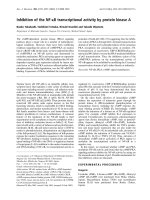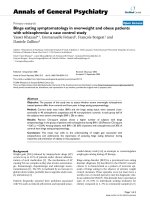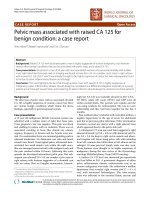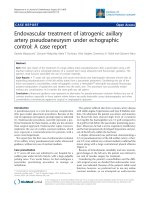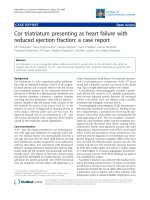báo cáo khoa học: "Severe propylthiouracil-induced hepatotoxicity in pregnancy managed successfully by liver transplantation: A case report" ppsx
Bạn đang xem bản rút gọn của tài liệu. Xem và tải ngay bản đầy đủ của tài liệu tại đây (266.32 KB, 3 trang )
CAS E RE P O R T Open Access
Severe propylthiouracil-induced hepatotoxicity in
pregnancy managed successfully by liver
transplantation: A case report
Evan Sequeira, Sikolia Wanyonyi
*
and Raj Dodia
Abstract
Introduction: Propylthiouracil-induced severe hepatotoxicity is a relatively rare occurrence, with very few cases
reported in the literature. The management of this complication in pregnancy can be a challenge because of the
effects of the various treatment options on the fetus.
Case presentation: We report a rare case of fulminant hepatic failure in a 36-year-old gravida 2 black woman of
African descent that occurred at 17 weeks gestation following prop ylthiouracil treatment for Graves’ disease. Her
liver failure was managed by liver transplantation and thyroidectomy. Her pregnancy was continued to term,
though with not so favorable early childhood sequelae.
Conclusion: This case illustrates a very rare complication of treatment with a presumed safe drug during
pregnancy followed by adverse neonatal outcomes due to the extensive treatment.
Introduction
Propylthiouracil (PTU)-induced severe hepatotoxicity is
a relatively rare occurrence, despite observed transient
increases in liver function test values at the initiation of
treatment [1,2]. A one in 10,000 incidence of liver fail-
ure following PTU treatment has been reported in the
United States of America [3]. Fulminant hepatic failure
during pregnancy occurs more frequently in the third
trimester of gestation, and it s etiology usually derives
from obstetric-related conditions and/or infectious dis-
eases [4,5]. Management of this condition poses an ethi-
cal dilemma, as the clinician has to choose between
maternal well-being and fetal health. We report a rare
case of fulminant hepatic failure in the second trimester
following PTU treatment for severe thyrotoxicosis in
pregnancy that was successfully managed by liver trans-
plantation and thyroidectomy with a good outcome for
the mother but unfavorable neonatal sequelae.
Case presentation
A 36-year-old para 1+0, gravida 2{previous caesarean
delivery due to fetal distress, no miscarriages/abortion,
with one living child} black woman of African descent
was diagnosed with Graves’ thyrotoxicosis at seven
weeks gestation. Her antenatal profile had be en unre-
markable and she did not have any comorbidities. There
was no relevant family history, and she neither smoked
cigarettes nor consumed alcohol. Her previous preg-
nancy had been uneventful, and she had delivered a
healthy baby normally. She presented to our hospital
with unexplained palpitations, tachycardia, and excessive
sweating. Her examination revealed that she had
obvious proptosis. Her cardiovascular and respiratory
examinations were normal. We ordered thyroid function
tests in view of this presentation. Her thyroid-stimulat-
ing hormone level was 0.06 μU/mL (normal range, 0 .27
to 4.2 μU/mL), free tri-idothyroni ne (T3) was 21.08 pg/
mL (normal range in first trimester, 2.5 to 3.9 pg/mL),
and free thyroxine (T4) was 54.39 ng/mL (normal range
in first trimester, 0.9 to 1.5 ng/mL). Her antenatal book-
ing tests and ultrasonography were unremarkable. At 10
weeks gestation, following consultation with an endocri-
nologist, she was commenced on PTU 100 mg thrice
daily, which led to significant improvement in her thyr-
oid function tests. At 17 weeks gestation, she developed
scleral icterus. Upon further evaluation at a hospital in
the US, a diagnosis of fulminant hepatitis was made.
* Correspondence:
Aga Khan University Hospital, PO Box 30270, Nairobi 00100 GPO, Kenya
Sequeira et al. Journal of Medical Case Reports 2011, 5:461
/>JOURNAL OF MEDICAL
CASE REPORTS
© 2011 Sequeira et al; licensee BioMed Central Ltd. This is an Open Access article distributed under the terms of the Creative
Commons Attr ibution License (http ://creativecom mons.org/licenses/by/2.0), which permits unr estricted use, distribution, and
reproduction in any medium, provided the original work is properly cited.
Conservative management with plasmapharesis and
intravenous steroids was attempted, but her condition
deteriorated to stage IV liver failure, necessitating inten-
sive care with ventilatory support. Subsequently, a liver
transplant was performed at 18 weeks gestation, fol-
lowed by a thyroidectomy two weeks later.
After undergoing transplantation, she was continued
on immunosuppressive therapy with tacrolimus, cyclos-
porine, prednisolone, and thyroid hormone replacement
with levothyroxine. Her antenatal care was continued in
Nairobi, Kenya, after her discharge from the hospital in
the US.
Ultrasonography performed at 33 weeks gestation con-
firmed fetal growth restriction, oligohydramnios, and
communicating ventriculomegaly with reduced cerebral
volume. The mother underwent elective cesarean sec-
tion at 37 weeks gestation. A female baby was delivered
with Apgar scores of 8 at one minute and 10 at five
minutes, weight 2050 g, and microcephaly (head circum-
ference28cm).ThebabyhadMRIfeaturessuggestive
of antenatal is che mic encephalopathy and h ad frequent
episodes of f ocal seizures, which were controlle d with
clonazepam. Steady but slow growth was reported, with
delayed developmental milestones, and the baby is cur-
rently undergoing rehabilitation. Since delivery, the
mother’s thyroid and liver function tests have remained
normal.
Discussion
PTU inhibits the peripheral conversion of T4 to T3.
Like methimazole (MMI), it inhibits the utilization of
iodine by the thyroid gland. In pregnancy, PTU is pre-
ferred to MMI because MMI is associated with a very
rare congenital anomaly, aplasia cutis, if administered
during the first trimester. However, this risk is negligible
and does not persist beyond the critical period of orga-
nogenesis [2]. PTU is also preferred to MMI in life-
threatening thyrotoxicosis and thyroid storm because of
its ability to inhibit peripheral conversion of T4 to T3.
It is also reserved for patients who experience adverse
effects resulting from MMI or when radioiodine treat-
ment or surgery is not a suitable option [6]. The starting
dose of PTU is 100 mg thrice daily [2]. Pregnancy-speci-
fic changes affecting thyroid function and iodine meta-
bolism do not influence dosage.
Unlike MMI, the side effects of PTU are not dose-
related. About 5% of patients experience cutaneous reac-
tions, arthralgia, and gastrointestinal upset [7]. Agranu-
locytosis occurs in 0.37% of p atients receiving PTU [8].
The frequency of hepatotoxicity ranges from 0.1% to
0.2% [7]. PTU-induced hepatotoxicity can occur at any
time during the course of treatment. Its onset is sudden
and rapidly progressive [6,9]. Our patient had been on
treatment for eight weeks when the diagnosis was made.
The America Thyroid Association and the US Food
and Drug Administration (FDA) do not recommend
routine monitoring of white blood cell co unt, liver fun c-
tion, and hepatocellular integrity for PTU-induced liver
failure in asymptomatic patients since the onset is
usually very rapid. However, these tests are useful in
symptomatic patients [6]. Our patient underwent these
tests when she complained of jaundice. PTU-related
hepatotoxicity is associated with marked elevation in
aminotransferase and massive hepatic necrosis on
biopsy. These findings were confirmed by histopatholo-
gic examination of the liver in our patient.
Therapy consists of immediate cessation of PTU along
with expectant management of the potential complica-
tions of hepatic failure. A fatality rate of 25% to 50% has
been reported in these patients, even though milder
cases that resolve un eventfully might not have been
reported in the literature [2,10].
In severe cases of end-stage liver failure, liver trans-
plantation may be required [11], though successful treat-
ment with plasmaphares is has also been reported [12].
These treatm ents are offered only in specia lized centers
of excellence. As such, our patient could not g et treat-
ment locally even if she wished to. The main challenge
with liver transplantation in pregnancy is that many
medication s used in post-transplant immunosuppression
may have adverse effects on the fetus, some of which
manifested after birth in our case. There are also ethical
issues to contend w ith concerning the likely survival of
both the mother and the fetus. A case-control analysis
of pregnancy outcomes among liver transplant recipients
found most outcomes t o be favorable, although there
was an increase in rates of mi scarriages, pre-term labor,
intra-uterine growth restriction, post-partum hemor-
rhage, and gestational hypertension [13]. To the best of
our knowledge, 12 cases of liver transplantation for ful-
minant hepatic failure between the 13th and 27t h weeks
of pregnancy have been reported in the literature, with a
fetal survival rate of 36% [4,5,13].
Conclusion
Our case illustrates a very rare complication of a presumed
safe drug in a patient requiring a liver transplant and thyr-
oidectomy that echoes the FDA warning on the drug. The
unfavorable neonatal outcome may have been due to com-
bined or individual effects of immunosuppressive therapy,
prolonged episodes of hypoxia due during assisted ventila-
tion at surgery, or the disease process itself.
Consent
Written informed consent was obtained from the patient
for publication of this case report and any accompany-
ing images. A copy of the written consent is available
for review by the Editor-in-Chief of this journal.
Sequeira et al. Journal of Medical Case Reports 2011, 5:461
/>Page 2 of 3
Acknowledgements
We thank all of the midwives, nurses, theater staff, and the pediatrician who
took part in the treatment of this patient.
Authors’ contributions
ES managed this patient during pregnancy, provided his professional
opinion throughout the management of the patient, obtained consent from
the patient for publication of this case report, is the custodian of the
patient’s records and contributed to the writing of the final manuscript. SW
summarized the case, did the literature search, and was a major contributor
to the writing of the manuscript. RD also did the case summary by
compiling all the medical reports and contributed extensively to the writing
of the manuscript and interpretation of the results. All authors read and
approved the final manuscript.
Competing interests
The authors declare that they have no competing interests.
Received: 27 May 2011 Accepted: 19 September 2011
Published: 19 September 2011
References
1. Benyounes M, Sempoux C, Daumerie C, Rahier J, Geubel AP:
Propylthiouracil-induced severe liver toxicity: an indication for alanine
aminotransferase monitoring? World J Gastroenterol 2006, 12:6232-6234.
2. Cooper DS: Antithyroid drugs. N Engl J Med 2005, 352:905-917.
3. Kim HJ, Kim BH, Han YS, Yang I, Kim KJ, Dong SH, Kim HJ, Chang YW,
Lee JI, Chang R: The incidence and clinical characteristics of symptomatic
propylthiouracil induced hepatic injury in patients with hyperthyroidism:
a single-center retrospective study. Am J Gastroenterol 2001, 96:165-169.
4. Toti L, Manzia TM, Romano P, Lenci I, Baiocchi L, Anselmo A, Sforza D,
Manuelli M, Tisone G: Successful management of a same day emergency
delivery and liver transplant in a 27 weeks pregnant woman with
fulminant hepatic failure. Transpl Int 2010, 23:114-115.
5. Rahman TM, Wendon J: Severe hepatic dysfunction in pregnancy. QJ
Med 2002, 95:343-357.
6. Bahn RS, Burch HS, Cooper DS, Garber JR, Greenlee CM, Klein IL, Laurberg P,
McDougall IR, Rivkees SA, Ross D, Sosa JA, Stan MN: The role of
Propylthiouracil in the management of Graves’ disease in adults: report
of a meeting jointly sponsored by the American Thyroid Association
and the Food and Drug Administration. Thyroid 2009, 19:673-674.
7. Cooper DS: Antithyroid drugs in the management of patient’s with
Graves’ disease: an evidence-based approach to therapeutic
controversies. J Clin Endocrinol Metab 88:374-381.
8. Tajiri J, Noguchi S: Antithyroid drug induced agranulocytosis: special
reference to normal white blood cell count agranulocytosis. Thyroid
2004, 14:459-462.
9. Williams KV, Nayak S, Becker D, Reyes J, Burmeister LA: Fifty years of
experience with propylthiouracil-associated hepatotoxicity: what have
we learned? J Clin Endocrinol Metab 1997, 82:1727-1733.
10. Ruiz JK, Rossi GV, Vallejos HA, Brenet RW, Lopez IB, Escribano AA: Fulminant
hepatic failure associated with propylthiouracil. Ann Pharmacother 2003,
37:224-228.
11. Russo MW, Galanko JA, Shrestha R, Fried MW, Watkins P: Liver
transplantation for acute liver failure from drug induced liver injury in
the United States. Liver Transpl 2004, 10:1018-1023.
12. Aydemir S, Ustundag Y, Bayraktaroglu T, Tekin IO, Peksoy I, Unal AU:
Fulminant hepatic failure associated with propylthiouracil: a case report
with treatment emphasis on the use of plasmapheresis. J Clin Apher
2005, 20:235-238.
13. Coffin CS, Shaheen AAM, Burak KW, Myers RP: Pregnancy outcomes
among liver transplant recipients in the United States: a nationwide
case-control analysis. Liver Transpl 2010, 16:56-63.
doi:10.1186/1752-1947-5-461
Cite this article as: Sequeira et al.: Severe propylthiouracil-induced
hepatotoxicity in pregnancy managed successfully by liver
transplantation: A case report. Journal of Medical Case Reports 2011 5:461.
Submit your next manuscript to BioMed Central
and take full advantage of:
• Convenient online submission
• Thorough peer review
• No space constraints or color figure charges
• Immediate publication on acceptance
• Inclusion in PubMed, CAS, Scopus and Google Scholar
• Research which is freely available for redistribution
Submit your manuscript at
www.biomedcentral.com/submit
Sequeira et al. Journal of Medical Case Reports 2011, 5:461
/>Page 3 of 3
